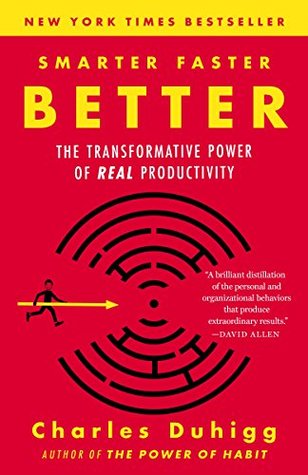More on this book
Community
Kindle Notes & Highlights
Read between
June 12 - June 17, 2019
Productivity, put simply, is the name we give our attempts to figure out the best uses of our energy, intellect, and time as we try to seize the most meaningful rewards with the least wasted effort.
Rather, productivity is about making certain choices in certain ways. The way we choose to see ourselves and frame daily decisions; the stories we tell ourselves, and the easy goals we ignore; the sense of community we build among teammates; the creative cultures we establish as leaders: These are the things that separate the merely busy from the genuinely productive.
Motivation is more like a skill, akin to reading or writing, that can be learned and honed. Scientists have found that people can get better at self-motivation if they practice the right way. The trick, researchers say, is realizing that a prerequisite to motivation is believing we have authority over our actions and surroundings. To motivate ourselves, we must feel like we are in control.
Alternately, another engineer told the researchers that his “team leader has poor emotional control. He panics over small issues and keeps trying to grab control. I would hate to be driving with him in the passenger seat, because he would keep trying to grab the steering wheel and crash the car.” That team did not perform well.
In contrast, the norms of her case competition team—enthusiasm for one another’s ideas, withholding criticisms, encouraging people to take a leadership role or hang back as they wanted—allowed everyone to be friendly and unconstrained. Coordination was easy.
“The units with the strongest sense of teamwork would have the lowest error rates.” Except, when she tabulated her data, Edmondson found exactly the opposite. The wards with the strongest team cohesion had far more errors. She checked the data again. It didn’t make any sense. Why would strong teams make more mistakes?
To become genuinely productive, we must take control of our attention; we must build mental models that put us firmly in charge.
When people rush toward decisions simply because it makes them feel like they are getting something done, missteps are more likely to occur.
There is the need to “seize” a goal, as well as a separate urge to “freeze” on an objective once it has been selected. Decisive people have an instinct to “seize” on a choice when it meets a minimum threshold of acceptability. This is a useful impulse, because it helps us commit to projects rather than endlessly debating questions or second-guessing ourselves into a state of paralysis. However, if our urge for closure is too strong, we “freeze” on our goals and yearn to grab that feeling of productivity at the expense of common sense. “Individuals with a high need for cognitive closure may
...more
How, they wondered, do you get people to think expansively all the time?
Stretch goals, paired with SMART thinking, can help put the impossible within reach.


